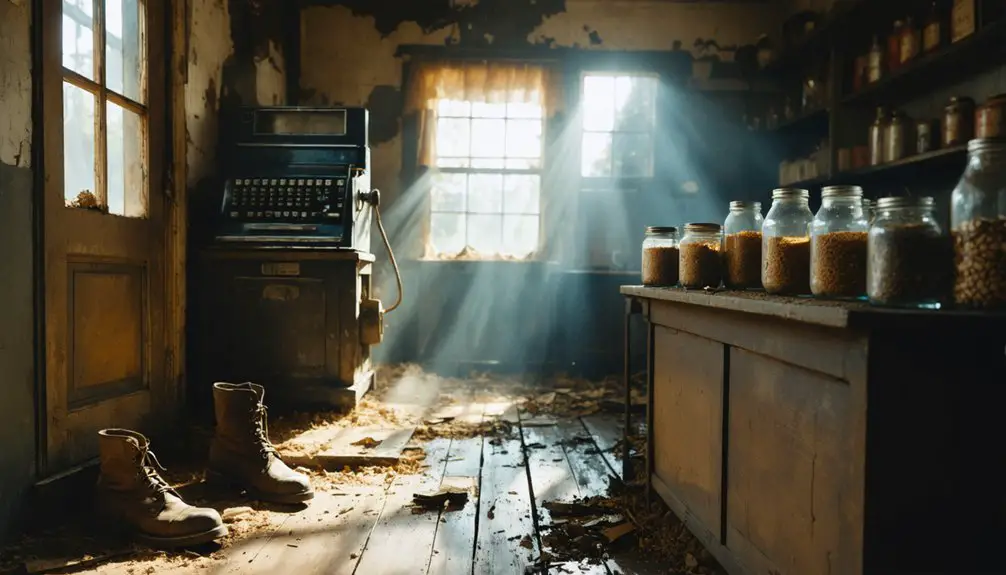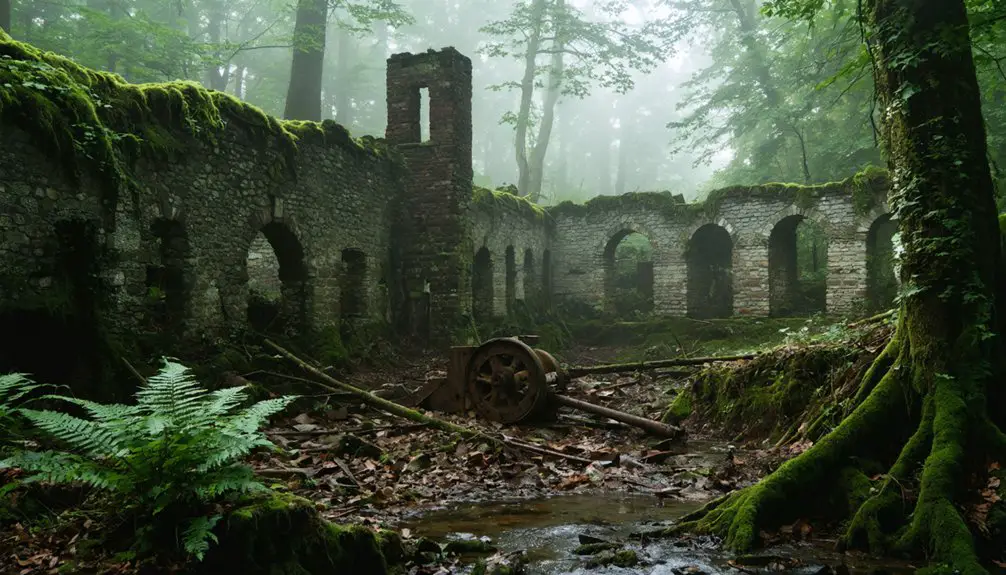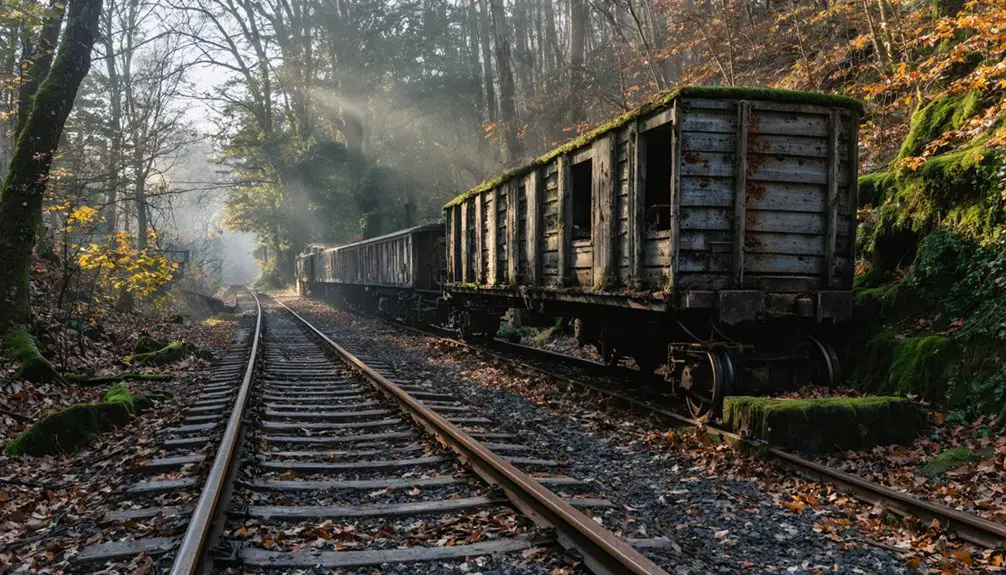You’ll find Bear Run‘s story in Jefferson County, Pennsylvania, where Thomas Taylor Boswell established a coal mining town in the early 1900s. The community thrived around the Bloss vein coal deposits, complete with row houses, company stores, and railroad connections. When the Great Depression hit, coal prices plummeted, forcing the Bear Run Coal & Coke Company to shut down by 1929. Today, archaeological surveys and preserved ruins reveal fascinating details about this once-bustling mining settlement.
Key Takeaways
- Bear Run was a coal mining town established in the early 1900s by Thomas Taylor Boswell in Jefferson County, Pennsylvania.
- The town’s economy collapsed during the Great Depression when coal prices plummeted, leading to widespread mine closures.
- An underground coal fire made living conditions hazardous, forcing residents to abandon their homes due to toxic gases.
- The community featured company-owned houses, stores, and facilities, typical of Pennsylvania coal towns in the early 20th century.
- Archaeological studies now use ground-penetrating radar and LIDAR technology to preserve Bear Run’s mining heritage and history.
The Coal Mining Legacy
While Pennsylvania’s coal mining history spans centuries, Bear Run’s story began with Thomas Taylor Boswell’s establishment of the Bear Run Coal & Coke Company in the early 1900s.
Pennsylvania’s rich coal legacy took root at Bear Run when T.T. Boswell founded his coal and coke operation in the 1900s.
You’ll find evidence of this coal mining legacy in the horizontal drift mines near Sidney in Jefferson County, where railroads and schools once supported thriving communities. The mill pond operations at Grahams Mill preceded the mining development.
The economic impact rippled through the region as Boswell, who’d previously led Merchants’ Coal Company, connected Bear Run’s operations to Pittsburgh’s Hillman Coal through extensive rail networks. The Great Depression era forced many smaller operations to shut down permanently.
By 1940, the landscape had dramatically changed – Sidney and other mining villages vanished as the industry declined.
The environmental toll was steep: by 2012, abandoned mine drainage had impaired nearly 18 miles of streams in the Bear Run watershed.
Rise of a Company Town
The rise of Bear Run as a company town began with its incorporation in the mid-1800s under Thomas Taylor Boswell’s leadership, following his success with Merchants’ Coal Company and the town of Boswell, PA.
Initially called Draketown, the settlement’s company influence shaped its development and town identity, eventually leading to its renaming as Arnot after company incorporator John Arnot.
The town flourished as miners extracted the rich Bloss vein coal deposits.
You’ll find Bear Run’s rapid growth was marked by the construction of essential infrastructure: a sawmill by 1867, railroad connections, and multiple mining drifts.
The Baltimore-based company controlled every aspect of life, from housing to stores and social facilities.
By 1916, Edgar J. Kaufmann Sr. transformed part of the area into a summer retreat for his employees.
Daily Life in Bear Run

Life in Bear Run centered around the demanding rhythms of coal mining, with most residents working grueling 10-12 hour shifts underground. You’d wake early to join your fellow miners, facing hazardous conditions and constant exposure to coal dust during your workday.
After your shift, you’d return to your modest wooden or brick row house, where daily routines revolved around the mining schedule. Community gatherings at local churches provided essential social support, while company stores supplied your basic needs, often through a credit system. Similar to the concerns in nearby mining areas, many worried about the long-term health effects of cancer from radon. The abandoned buildings and empty streets would eventually remind visitors of ghost towns like Centralia.
Your children would attend the small local school, and you’d find brief moments of leisure through sports or music events. Despite the harsh conditions and limited amenities, you’d find strength in the tight-knit community, where neighbors understood the shared challenges of mining life.
Mining Operations and Infrastructure
Founded in 1888, Bear Run Mine emerged as a significant coal operation under the Blossburg Coal Mining and Railroad Company’s management.
You’ll find that mining techniques centered on room and pillar methods, with drifts providing horizontal access to coal seams within the Allegheny Group strata of the Blossburg syncline.
Transportation routes proved essential to Bear Run’s success. The Arnot and Pine Creek Railroad Company, established in 1881, connected the mine to broader markets through an extensive rail network. Today, the area encompasses Bear Run Nature Reserve, spanning over 5,000 acres of protected natural land.
You can trace the rail lines from Blossburg through Arnot to Landrus, complete with railway sidings and a station.
This infrastructure didn’t just move coal – it supported a thriving sawmill near Arnot, demonstrating how the region’s mining and timber industries worked hand in hand to fuel economic growth.
Notable Historic Landmarks
When you explore Bear Run’s historic district, you’ll find the prominent remnants of Collapsed Mine Entry #1, which served as a primary access point during the area’s peak mining years.
The mine entrance’s deteriorating timber supports and partially exposed stone archway offer a glimpse into the industrial heritage that once dominated this landscape. Today, the area is part of the Bear Run Nature Reserve, spanning over 5,100 acres of protected wilderness.
Just downhill, you can trace the concrete foundations of the former company store, where miners and their families once purchased supplies using company scrip. A nearby stone arch bridge carried stagecoaches and travelers across James Run Creek until at least 1911.
Collapsed Mine Entry #1
Despite its deteriorating condition, Collapsed Mine Entry #1 stands as one of Bear Run’s most significant historical landmarks from the early 20th-century coal mining era.
You’ll find this former ventilation shaft or haulage point surrounded by fallen timber supports and rock debris, telling the story of Pennsylvania’s industrial heritage.
When exploring near the collapsed entry, you’ll need to be aware of these hazards:
- Toxic gas emissions like methane and carbon monoxide
- Unstable ground conditions and surface subsidence
- Acid mine drainage from exposed rock surfaces
The entry’s historical significance extends beyond its physical remains – it’s a reflection of the region’s coal mining legacy and the technological challenges miners faced. A devastating accident in May 25, 1904 claimed the lives of 10 miners here due to toxic gas buildup.
Today, it serves as both a memorial to mining communities and a focal point for industrial archaeological research.
Company Store Foundations
Among Bear Run’s most revealing archaeological sites, the remaining company store foundations offer vital insights into the coal town’s socioeconomic structure.
These stone and concrete remnants showcase typical company store architecture, with evidence of large retail spaces, loading docks, and cellar openings that once supported bustling commercial activity.
You’ll find clues of economic dependency in the foundations’ layout, which reflects the era’s credit-based system where miners relied heavily on company stores for their daily needs.
The proximity of these foundations to mine entrances and worker housing reveals the careful planning that went into controlling the workforce’s access to goods.
Today, archaeologists use ground-penetrating radar and soil analysis to study these foundations, preserving significant information about life in this once-thriving mining community.
The Great Depression Era
You’ll find Bear Run’s mining operations drastically declined during the Great Depression, as coal prices plummeted and demand waned.
The economic devastation forced many local miners and their families to abandon their homes in search of work elsewhere, leaving behind a dwindling population.
While the wealthy Kaufmann family maintained their presence at Bear Run through their estate development, the working-class community that once thrived around the mines steadily transformed into a ghost town.
Mining Operations Halt
As the Great Depression struck in 1929, Bear Run’s once-thriving mining operations ground to a near halt.
The Bear Run Coal & Coke Company faced devastating losses as coal prices plummeted and industrial demand vanished.
Mining techniques that had served the region well became too expensive to maintain as equipment aged and infrastructure crumbled.
The collapse of operations brought three major changes:
- Mass layoffs swept through the mines, leaving countless workers without income.
- Labor relations deteriorated as strikes subsided due to workers’ desperate need to keep any employment.
- Company-owned infrastructure, including rail lines and drift entrances, fell into disrepair.
Community Exodus Begins
When the Bear Run Coal & Coke Company’s operations collapsed in 1929, the town’s population began a swift and irreversible decline. You’d have witnessed families packing up their lives as the Great Depression’s grip tightened, forcing them to seek opportunities elsewhere.
Community ties, once strong through shared mining work and social gatherings, unraveled as residents dispersed to urban centers and surviving mining towns like Boswell.
The exodus hit Sidney village particularly hard. You’d have seen schools and company stores shuttering their doors, while infrastructure crumbled without maintenance.
The economic resilience of Bear Run couldn’t withstand the nationwide downturn, and by the late 1930s, even the Kaufmann family’s summer retreat saw diminishing use.
Extended family networks, built over generations of industrial work, dissolved as Bear Run transformed into a ghost town.
Reasons for Abandonment

The decline of Bear Run stemmed from multiple interconnected factors that made the town increasingly uninhabitable.
The underground coal fire burning for over 50 years beneath the town caused severe environmental degradation, releasing toxic gases and creating dangerous ground instability.
You’ll find the economic repercussions were equally devastating when the coal industry collapsed, eliminating jobs and forcing residents to seek opportunities elsewhere.
Three key factors sealed Bear Run’s fate:
- Toxic gases venting through ground cracks made living conditions hazardous
- Mine closures and decreasing coal demand destroyed the local economy
- Deteriorating infrastructure and isolation from transportation routes cut off crucial supply chains
Without residents to maintain buildings or community structures, nature quickly reclaimed the abandoned town.
Mapping the Ghost Town Today
Located within the Bear Run Nature Reserve, mapping today’s ghost town requires careful navigation across 5,100 acres of varied terrain in Fayette County, Pennsylvania.
You’ll find the site approximately 3 miles south of Mill Run, accessible via PA Route 381, with GPS coordinates centered at 39.906115, -79.459889.
For ghost town mapping of historical significance, you’ll need to download trail maps before arrival due to spotty cell reception.
The site lies within second-growth hardwood forests on Laurel Hill’s western flank, crossed by Bear Run and Laurel Run streams.
You can explore over 20 miles of rugged hiking trails, but you’ll need to proceed on foot – vehicles aren’t allowed.
Key landmarks and numbered points on official maps will help you navigate while discovering remnants of the abandoned settlement.
Archaeological Discoveries

You’ll find evidence of Bear Run’s mining past in the scattered equipment and industrial artifacts uncovered through archaeological excavations, including wire wound nails, files, and remnants of extraction operations.
The foundations of former buildings reveal settlement patterns, with a notable earthen foundation discovered 60 meters south of the spring marking a small residential structure.
The site’s archaeological significance extends to burial grounds, where unexpected finds like the Marino Marini’s Horseman sculpture fragment have emerged from flood sediments, connecting the area’s industrial heritage to its cultural history.
Mining Equipment Found
Archaeological excavations at Bear Run have revealed an extensive collection of late 19th and early 20th century mining equipment, offering valuable insights into Pennsylvania’s industrial heritage.
You’ll find evidence of mining technology shifts through preserved artifacts scattered across the ghost town site.
Here’s what archaeologists have discovered:
- Steam-powered machinery including hoists and winches used for lifting coal from deep mine shafts
- Coal breaker equipment with remaining conveyor systems and breaker houses
- Hand tools such as picks, shovels, and coal tongs that reveal the evolution from manual to mechanized mining
Despite challenges from acid mine drainage and dense vegetation, artifact preservation efforts continue through passive wetland treatment systems and careful documentation.
These discoveries help piece together the daily lives of coal miners and their contributions to Pennsylvania’s industrial development.
Building Foundation Patterns
Extensive foundations discovered at Bear Run disclose systematic patterns of 19th and early 20th-century coal town construction.
You’ll find foundation types ranging from traditional dry-laid stone masonry to later concrete structures, showcasing the evolution of building techniques. Local fieldstone served as the primary material, with larger foundations supporting communal buildings and smaller ones for worker housing.
The layout patterns follow a deliberate grid along main roads, with distinct clusters separating residential areas from operational zones.
You can trace standardized building footprints that reflect planned development, while terraced foundations demonstrate adaptation to Bear Run’s hilly terrain.
LIDAR technology and GPR have revealed hidden street patterns beneath the vegetation, helping archaeologists map the town’s original spatial arrangement despite minimal above-ground remains.
Cemetery and Burial Sites
Remnants of historic burial grounds near Bear Run offer essential insights into early mining community life, with several cemeteries discovered in nearby abandoned towns like McEntire.
You’ll find these burial sites are often the last remaining intact elements of former communities, following town abandonment due to mining decline and disease epidemics.
Archaeological surveys have revealed:
- Small historic artifacts near graves, including period coins and personal items from 19th and early 20th-century burials
- Preserved coffin hardware and burial ornaments that survived acidic soil conditions
- Headstones arranged in rows, marking organized burial lots typical of coal-era cemeteries
Cemetery preservation efforts face ongoing challenges from dense vegetation and site accessibility, while burial artifacts continue providing valuable data about demographic trends and mortality rates in these forgotten mining communities.
Preserving Bear Run’s Memory
The preservation of Bear Run’s historical legacy encompasses multiple ongoing initiatives across physical, digital, and educational domains.
You’ll find LIDAR mapping technology revealing the town’s original layout, while historical societies collect oral histories from miners’ descendants to maintain community narratives.
Through partnerships between universities and heritage organizations, you can explore digitized archives of photographs, maps, and mining records.
Local museums showcase Bear Run’s industrial heritage through exhibits and guided tours, while school programs integrate the town’s story into regional curricula.
You’ll notice physical preservation efforts including protective fencing around hazardous areas and maintenance of structural ruins.
Community engagement drives these historical preservation activities, with volunteer groups conducting archaeological surveys and clean-up operations to guarantee Bear Run’s story endures for future generations.
Frequently Asked Questions
Are There Any Surviving Former Residents of Bear Run Still Alive Today?
You won’t find any former residents alive today, as the town’s last inhabitants left by 1940. While ghost stories persist, anyone who lived there would now be well over 100 years old.
What Wildlife Species Now Inhabit the Abandoned Town Site?
You’ll find abundant wildlife sightings at the old town site, including black bears, fishers, bobcats, and over 53 bird species. The area’s species diversity extends to brook trout and thousands of invertebrates.
Were Any Movies or Documentaries Ever Filmed at Bear Run?
Like a blank canvas waiting for its story, you won’t find any documented film locations or ghost stories captured on camera at this site – no movies or documentaries were ever filmed here.
Does Anyone Own the Bear Run Property Now?
Yes – the Western Pennsylvania Conservancy owns and manages Bear Run’s 5,162 acres. They’ve acquired the property piece by piece since 1963, transforming it from industrial land into a public nature reserve.
Are There Paranormal Activity Reports Associated With Bear Run’s Ruins?
You won’t find documented ghost sightings or haunted locations at Bear Run’s ruins. Unlike Centralia, which is known for paranormal claims, Bear Run’s reputation remains focused on historical and archaeological interests.
References
- https://www.youtube.com/watch?v=Qj5LjacccJ0
- http://ironequine.com/history-bits/history-of-sidney-keal-run-lochvale-pennsylvania/
- https://www.mountainhomemag.com/2023/03/01/427378/ghosts-of-mine-street
- https://pawilds.com/historic-ruins-pennsylvania-wilds/
- https://en.wikipedia.org/wiki/List_of_ghost_towns_in_Pennsylvania
- https://www.heritagejohnstown.org/attractions/heritage-discovery-center/johnstown-history/history-coal-cambria-county/
- https://www.iup.edu/library/departments/archives/coal/coal-culture-timeline.html
- https://www.srbc.gov/our-work/reports-library/technical-reports/290-bear-run-mine-drainage-restoration/docs/bear-run-mine-drainage-restoration.pdf
- https://wynninghistory.com/blog/
- https://blossburg.org/town-info/william-b-wilson-history/william-b-wilson-arnot-pennsylvania/



